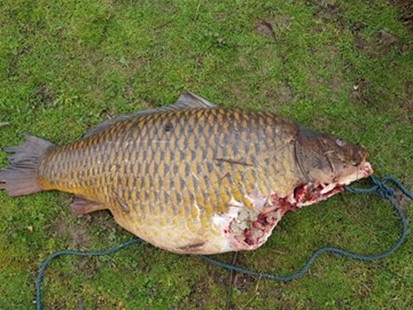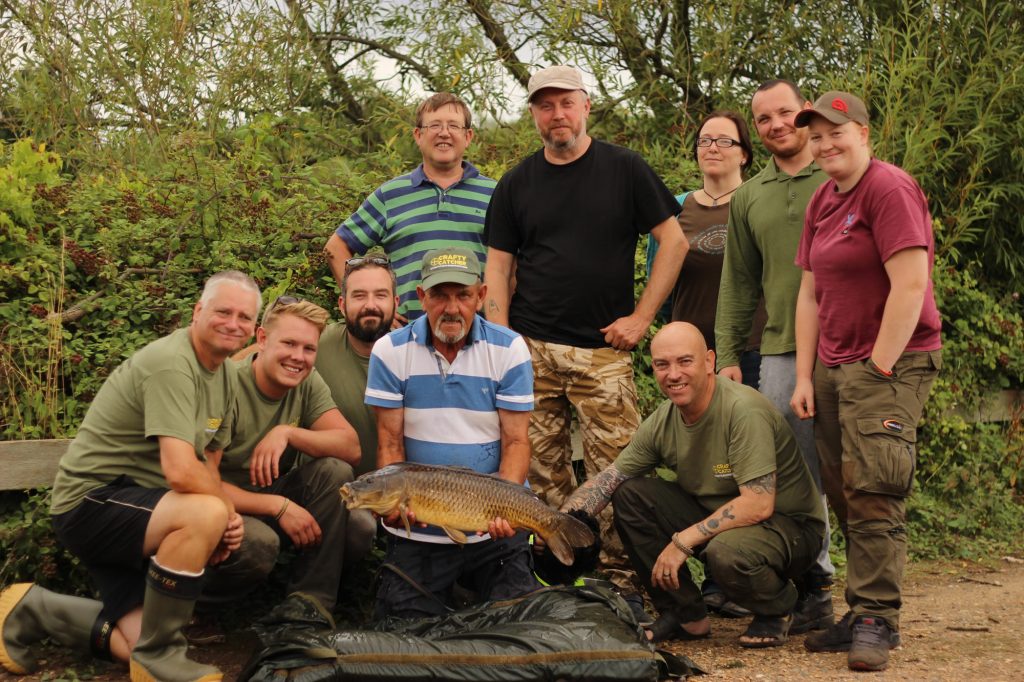Fisheries Management & Fencing
Otters are resourceful and quite good climbers, so to be absolutely certain they can’t access a fishery a robust fencing specification is needed, with the greatest success achieved with fences which are buried in the ground at the base, have electric scare wires and an outward overhang. When the Environment Agency and Wildlife Trusts were producing their recommendations in the Otters and Stillwater Fisheries (2008) guide, there was strong pressure from the fishing industry to recommend this robust solution as the preferred option, although it is expensive. Even with the high security solution, fishery managers and anglers have to remember to attend to weak spots and to secure the gates and then close them.
In recent years a great deal of time and effort has been given by those passionate about their sport in trying to find fencing solutions to the predation dilemma faced on some fisheries to safeguard their prized and highly valuable fish stock.
The Angling Trust is working closely with a variety of key stakeholders including Embryo, Otterstop, the Carp Society, the Predation Action Group, UK Wild Otter Trust as well as the Environment Agency to better protect fisheries.

A secure otter fence at Blakemere Leisure, funded by the Angling Improvement Fund
Otter Fencing Specification
Within Natural England’s Class Licence (WLM-CL36), Annex C provides guidance on the specification of the fence required to prevent an otter from gaining access to a fishery and to fulfil the licencing criteria.
The objective of otter fencing is to provide a robust, physical barrier that the otter can neither climb over nor pass through or under. Otters can pass through gaps greater than 75mm2 and an adult otter can easily stretch up to a height of 1m and can climb well.
Essentially, the fence can either be non-electrified or electrified, or a combination of the two as detailed below. In either case, fences must be regularly inspected and maintained, including clearance of overhanging and nearby vegetation.
Non-electrified Fence
- The fence should be constructed of material that otters cannot easily bite through, such as a mesh of at least 1.1mm diameter. The maximum mesh size for fencing to exclude otters should be change to 75mm2 , with specific light high tensile galvanised wire products measuring 50mm x 100mm.
- It should be at least 1800mm high if there is no overhang at the top or at least 1200mm if there is a 600mm overhang towards the outside.
- If possible it should be buried 300mm into the ground. At the bottom of the fence on the outside there should be a ‘skirt’ of at least 900mm of a suitably robust but flexible netting that is securely pinned on the ground. Grass should be allowed to grow up through the netting to help secure it to the ground.*
- Fence posts should be treated timber or metal with straining posts of 15mm (6 inch) diameter at appropriate distances to support the fence around all angles. All posts must be inside the mesh of the fence.
- The outside of any gates must be covered in sheet metal (e.g. galvanised tin) or the same wire as the fence (and to the same height). The covering must extend to just above the ground and over any hinges or gaps that the otter could use to climb or squeeze through. Gates should be set over a hard-standing or material that cannot be dug.
- Additional protection can be provided by including an electric ‘scare wire’ attached to the fence posts and positioned so that the otter will touch it and receive a shock if it tries to climb the fence.
- This should be positioned 50mm below the top of the fence and offset no more than 50mm out from the fence line.
- A second electric wire may be a useful deterrent in the absence of an overhang. It should be positioned at least 300mm from the ground and if possible 150mm in front of the fencing mesh.
*Refer to Aftercare Maintenance section on the website
Electrified Fence**
- Minimum requirement is 1.5 Joule energiser with a fast pulse rate.
- It is essential that vegetation is kept clear of the fence as this will short it
- The fence must be live as soon as it is erected to prevent otters from learning that they can cross it.
- Electric netting must be at least 700mm high
- Electric wire fencing usually comprises at least 3 parallel strands 70, 140 and 210mm from the ground. Four strand fences at 100, 150, 200 and 300mm above ground are also used. The wires must be prevented from touching each other.
- The wires must be tensioned by a reel post placed at the end of the fence and held by adjustable plastic insulators on metal stakes. Anchor posts should be used for bends and corners.
- The stakes should be spaced no more than 10m apart; they may need to be closer to cope with undulations in the ground.
**When using parallel strands of electric wire alone, it has been known for otters to still gain entry.
Embryo and Otterstop have been at the forefront of fencing fisheries to protect them from otter predation. A wealth of information is available to anyone considering fencing their waters on the following links:
Otterstop has produced a very informative video outlining some of the key features and techniques of installing a robust otter fence, which can be viewed here.
Please Note – Given the growing demand, there are now several reputable fencing contractors across the country and a few manufacturers/suppliers of specific high tensile otter fencing to choose from, so fisheries should consider all their options.
Similarly, the fencing is not restricted to light high tensile galvanised wire alone, with a few alternatives available to suit the particular site and budget, whether that is chain link, galvanised mesh (50mm2), hexagonal wire mesh, electric fencing etc.
Preliminary checks
Whether you intend to undertake the works yourself, or hire a contractor, a few preliminary checks may prove beneficial:
- Ensure you are legally entitled to erect the fence, or have the legal agreement of those parties who own the entire area of land & water body concerned.
- Ensure the area to be fenced is not a legally protected site, e.g. Site of Special Scientific Interest (SSSI), Special Area of Conservation (SAC), Special Protection Area (SPA) etc. If so, you should consult with the appropriate statutory authority.
- Depending on the finished height of the fence and the proximity to a public highway, check that planning permission is not required. If in doubt, consult with your local planning authority.
- Check the line of your proposed fence (including any overhang) is not impeding a public right of way.
- If your fence design incorporates an outward overhang, do not allow your overhang to straddle over, or beyond your legal boundary.
- Plan the fence line to avoid fencing in, or disturbing an active badger sett and ideally avoid active badger runs.
- Make sure that you don’t inadvertently fence an otter inside. It’s advisable to have a careful sweep through the fishery and islands before you secure the final section, although if you know there is already an active otter holt within the fishery you will need to discuss the licensing implications with Natural England. If possible, consider leaving a weather proof radio playing, and flashing lights for the final night before the site is enclosed.
- Depending on the surrounding tree cover and how much fence line clearance is required, check:
-
-
- Do you require a felling licence? (Ordinarily 5m3 per calendar quarter is permissible, but check with the relevant statutory body)
- Do you have the relevant owner’s permission before you start clearance works, or removing any tree boughs?
-
-
-
- Are the trees protected via Tree Preservation Orders, Listed Parks & Gardens, or does the site lie within a Conservation Area?
- Are there roosting/hibernating bats, or nesting birds present? If the latter, plan ahead and undertake the works outside of the bird nesting season.
-
-
- If the fencing works involves burying the ‘skirt’, be conscious of how much damage may be incurred to the surrounding tree roots, which may then subsequently either kill the tree, or weaken it sufficiently causing it to fall across the fence, highway, property etc. at a later date.
- Have your chosen contractors (or fishery, syndicate/club members) the relevant level of expertise & competence to erect a secure otter fence?
- Have the contractors (or fishery, syndicate/club members) the relevant third-party liability insurance cover?
- Have the contractors (or fishery, syndicate/club members) the relevant expertise to comply with the appropriate Health & Safety requirements?
- Is the fencing scheme notifiable under what is termed the Construction (Design and Management) Regulations 2015?
- In all cases, check the proposed fence line for overhead & underground cables/utilities etc
- If the line of the fence is close to a main river watercourse or is on an active flood flow route, it may require a Flood Risk Activity Permit from the Environment Agency. Please check https://flood-map-for-planning.service.gov.uk/ to confirm which watercourses are main river, or talk to your local Environment Agency office
If you are employing the services of a contractor and to avoid any misunderstanding, it would be advantageous to have a contract of agreement, between yourself as the client and the contractor undertaking the works, which includes a detailed specification of the materials to be used, illustration and methodology.
Upon completion, but ideally whilst works are being undertaken it is essential that the works are inspected, and any snagging problems resolved.

Large (and valuable) specimen carp are particularly vulnerable to otter predation, but many still water fisheries can be fenced to exclude otters. Grants are available from the Angling Improvement Fund (see below)
Attention to detail
- Ensure that all inlets & outlets, both above & below the water level are secure and otter proof. Some of these may need to be constructed so they can be removed and cleared of debris.
- Any low overhanging, dead, dying or diseased trees surrounding the fence should be removed.
- If a skirt is being incorporated within the fence design, ensure this is securely affixed to the ground along its entire length and ideally covered with soil, turf or aggregate.
- Ensure that all fence posts and especially straining posts/struts are erected inside the fence line to prevent them acting as a ramp thereby providing an otter with the opportunity to climb.
- Where two rolls of wire have been joined together, ensure that the spacing remains no greater than 50mm.
- Ensure that no fence wires have become broken or splayed, paying particular attention towards those at ground level.
- Gates should be hung so that when . there is no gap greater than 50mm on either the hanging or clashing side, or underneath the gate, whereby an otter may gain access. And, ensure there is a solid base beneath the gate to prevent an otter being able to dig underneath.
- Clearly sign post your gates to highlight that they need to be kept securely closed at all times and ideally incorporate a self-closing mechanism.
- Consider using combination locks, especially on gates which are infrequently used.
Need support? Contact our Fisheries Management Advisors
For further advice on otter related matters, please contact one of the Angling Trust’s Fisheries Management Advisors:
North West, North East, Yorkshire and Humber, Lincolnshire, East Midlands, West Midlands:
Richard Bamforth: richard.bamforth@anglingtrust.net | 07904 041518
South West, South East, London, South Midlands, East of England:
Jake Davoile: jake.davoile@anglingtrust.net | 07949 703206











